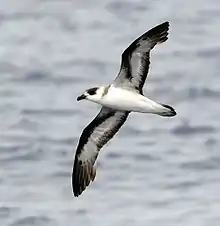Gadfly petrel
The gadfly petrels or Pterodroma are a genus of about 35 species of petrels, part of the seabird order Procellariiformes. The gadfly petrels are named for their speedy weaving flight, as if evading gadflies (horseflies). The flight action is also reflected in the name Pterodroma, from Ancient Greek pteron, "wing" and dromos, "runner".[1]
| Gadfly petrels | |
|---|---|
 | |
| Black-capped petrel (Pterodroma hasitata) | |
| Scientific classification | |
| Kingdom: | Animalia |
| Phylum: | Chordata |
| Class: | Aves |
| Order: | Procellariiformes |
| Family: | Procellariidae |
| Genus: | Pterodroma Bonaparte, 1856 |
| Species | |
|
About 35, see text | |
| Diversity | |
| 1 genus and 33 species | |
The short, sturdy bills of these medium to large petrels are adapted for soft prey that they pick from the ocean surface. They have twisted intestines for digesting marine animals that have unusual biochemistries.
Their complex wing and face marking are probably for interspecific recognition.
These birds nest in colonies on islands and are pelagic when not breeding. One white egg is laid usually in a burrow or on open ground. They are nocturnal at the breeding colonies.
While generally wide-ranging, most Pterodroma species are confined to a single ocean basin (e.g. Atlantic), and vagrancy is not as common amongst the genus as in some other seabird species (c.f. the storm petrels Hydrobatidae).
Species in taxonomic order
The taxonomy of the gadfly petrels is being refined at the moment. Several genera have been split off over time, as they are closer to the procellarine and Puffinus shearwaters. Some subspecies have been raised to full species rank. The arrangement given here is traditional, but annotates the changes proposed by Austin (1998)[2] and Bretagnolle et al. (1998).[3] For the current taxonomy, see also Brooke (2004).[4]
- Genus Pterodroma
- Pterodroma baraui, Barau's petrel (Indian Ocean basin)
- Pterodroma arminjoniana, Trindade petrel (Atlantic Ocean basin, with eccentric breeding locality in the Indian Ocean at Round Island, Mauritius)
- Pterodroma heraldica, herald petrel (Pacific Ocean basin) – recognized by the IOC and Clements.[5] However, the SACC has not recognized the split yet.
Split from Pterodroma arminjoniana - Pterodroma externa, Juan Fernández petrel (Pacific Ocean basin)
- Pterodroma neglecta, Kermadec petrel (Pacific Ocean basin, with eccentric breeding locality in the Indian Ocean at Round Island, Mauritius)
- Pterodroma phaeopygia, Galápagos petrel (Pacific Ocean basin)
- Pterodroma sandwichensis, Hawaiian petrel (Pacific Ocean basin)
- Pterodroma atrata, Henderson petrel (Pacific Ocean basin)
- Pterodroma alba, Phoenix petrel (Pacific Ocean basin)
- Pterodroma feae, Fea's petrel (Atlantic Ocean basin)
- Pterodroma desertae, Desertas petrel (disputed) (Atlantic Ocean basin)
- Pterodroma madeira, Zino's petrel or Madeira petrel (Atlantic Ocean basin )
- Pterodroma sp., Canary Islands petrel, (prehistoric) – possibly extirpated population of extant species[6]
- Pterodroma mollis, Soft-plumaged petrel (Atlantic Ocean, Indian Ocean and margins of Western Pacific Ocean)
- Pterodroma cahow, Bermuda petrel (Atlantic Ocean basin)
- Pterodroma hasitata, Black-capped petrel (Atlantic Ocean basin)
- Pterodroma caribbaea, Jamaican petrel, (possibly extinct) (Atlantic Ocean basin)
- Pterodroma incerta, Atlantic petrel (Atlantic Ocean basin)
- Pterodroma lessonii, White-headed petrel (Southern Ocean)
- Pterodroma magentae, Magenta petrel (Pacific Ocean basin, but poorly known)
- Pterodroma macroptera, Great-winged petrel (Indian and Atlantic basins)
- Pterodroma gouldi, Grey-faced petrel (Pacific Ocean basin)
- Pterodroma solandri, Providence petrel (Pacific Ocean basin)
- Pterodroma ultima, Murphy's petrel (Pacific Ocean basin)
- Pterodroma cf. leucoptera, Mangareva petrel, (possibly extinct)
- Pterodroma cervicalis, White-necked petrel (Pacific Ocean basin)
- Pterodroma occulta, Vanuatu petrel or Falla's petrel (Pacific Ocean basin)
- Split from Pterodroma cervicalis
- Pterodroma imberi, Imber's petrel, (extinct)[7][8]
- Pterodroma sp., (prehistoric, Henderson Island)[9]
- Pterodroma jugabilis, O'ahu petrel, (prehistoric)
- Subgenus Cookilaria[10]
- Pterodroma cookii, Cook's petrel (Pacific Ocean basin)
- Pterodroma pycrofti, Pycroft's petrel (Pacific Ocean basin)
- Pterodroma defilippiana, De Filippi's petrel or Masatierra petrel (Pacific Ocean basin)
- Pterodroma longirostris, Stejneger's petrel (Pacific Ocean basin)
- Pterodroma nigripennis, Black-winged petrel (Pacific Ocean basin with eccentric breeding locality in the Indian Ocean at Round Island, Mauritius)
- Pterodroma axillaris, Chatham petrel (Pacific Ocean basin)
- Pterodroma hypoleuca, Bonin petrel (Pacific Ocean basin)
- Pterodroma inexpectata, Mottled petrel (Pacific Ocean basin)
- Pterodroma leucoptera, Gould's petrel (Pacific Ocean basin)
- Pterodroma brevipes, Collared petrel (Pacific Ocean basin)
- Pterodroma brevipes magnificens, magnificent petrel, may be a full species (Pterodroma magnificens)[11]
A Pleistocene fossil from Aldabra in the Indian Ocean was described as Pterodroma kurodai. Biogeographically, it could belong to any genus.
See also
References
- Jobling, James A (2010). The Helm Dictionary of Scientific Bird Names. London: Christopher Helm. p. 322. ISBN 978-1-4081-2501-4.
- Austin, Jeremy J. (1996). "Molecular Phylogenetics of Puffinus Shearwaters: Preliminary Evidence from Mitochondrial Cytochrome b Gene Sequences". Molecular Phylogenetics and Evolution. 6 (1): 77–88. doi:10.1006/mpev.1996.0060. PMID 8812308.
- Bretagnolle, Vincent; Pasquet, Eric; Bretagnolle, V.; Attié, C.; Pasquet, E. (1998). "Cytochrome-B evidence for validity and phylogenetic relationships of Pseudobulweria and Bulweria (Procellariidae)" (PDF). Auk. 115 (1): 188–195. doi:10.2307/4089123.
- Brooke, M. (2004): Albatrosses and Petrels Across the World. Oxford University Press, Oxford, UK. ISBN 0-19-850125-0
- Proposed Splits (PS) and Newly Described Species (NEW) that are candidates for addition to the IOC World List. worldbirdnames.org
- Ardeola 49:39
- Notornis 41(S):165
- Bull BOC 135(3): 267–277
- AtollRes.Bull.325
- Onley, Derek and Paul Scofield (2007) Albatrosses, Petrels and Shearwaters of the World Helm Field Guides ISBN 978-0-7136-4332-9
- Bretagnolle, Vincent; Shirihai, Hadoram. "A new taxon of Collared Petrel Pterodroma brevipes from the Banks Islands, Vanuatu" (PDF). Bulletin of the British Ornithologists' Club. 130 (4): 286.